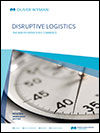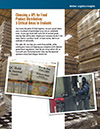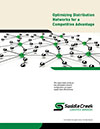Supply Chain Insights
A collection of the latest logistics and supply chain management industry whitepapers, eBooks, case studies and more.
FILTER BY CATEGORY
- 3PL
- 4PL & LLP
- Automation
- Barcode & RFID
- Bulk
- Canada Logistics
- Chemical Logistics
- Cold Chain Logistics
- Customs Compliance & Duty Drawback
- Data Analytics
- Data Management
- Demand Planning & Forecasting
- Distribution Center Management
- Drayage
- E-Commerce
- Education
- Finance
- Fleet Management
- Food Logistics
- Freight Forwarding
- Freight Payment, Audit & Billing
- Fulfillment / eFulfillment
- Global Logistics
- Global Trade
- HazMat
- Intermodal
- Labor Management
- Last Mile / Final Mile
- Lift Trucks / Forklifts
- Logistics IT
- Materials Handling
- Moisture & Temperature Control
- Ocean
- Package Delivery
- Packaging
- Parcel
- Ports
- Printers & Labels
- Rail
- Real Estate
- Refrigerated Warehousing
- Retail
- Retail Logistics
- Reverse Logistics
- Risk Management
- Robotics
- Routing, Scheduling & Shipping Technology
- Security Solutions
- Site Selection
- Small Package Services
- Sourcing & Negotiations
- Supply Chain Execution
- Supply Chain Management & Optimization
- Supply Chain Mgmt/Optimization
- Sustainability
- TMS
- Transportation
- Transportation & Freight Management
- Trucking
- Trucking-LTL
- Trucking-TL
- Vendor Compliance
- Visibility
- Warehousing
- Wireless/Mobile Technology
- WMS
- Yard Management

Understanding New Food Labeling Regulations
With the release of an overhaul to the BRC Issue 7 Food Safety guidelines, as well as further changes on the horizon for the EU and the United States, Mettler Toledo has compiled all the latest regulations in an easy-to-understand guide that goes through each set of regulations in detail. In addition to giving manufacturers a handy reference tool, this whitepaper also forecasts developments on the horizon, and recommends the best way to ensure compliance with labeling regulations moving forward.

660 Minutes: How Improving Driver Efficiency Increases Capacity
Recent industry research has found that since the July 2014 changes to Hours-of-Service, drivers spend an average of only 390 minutes (6.5 hours) of the 660 minutes of available driving time behind the wheel. There are many pressures acting upon capacity, and many upcoming regulations, which could inhibit driver hours. This whitepaper helps shippers and carriers attain a strong understanding of Hours-of-Service, and helps them pursue best practices for improved driver utilization.

Crossing Over: TMS Delivering Big Value for Small Shippers
No matter the size of your shipping operation, the logistics are complicated. Optimizing loads, reducing dock dwell, load tendering, meeting deadlines, and many other issues combine to challenge your business every day. Transportation Management Systems (TMS) have long been a mainstay in large shipping departments, while smaller shippers have been left using manual systems such as spreadsheets, or worse. Not anymore. A SaaS cloud-based TMS will show you the money – with little to no investment up front, and big value to your bottom line. Find out more by downloading this free whitepaper.

Industry Market Barometer
The news for the general economy may be mixed, but for manufacturers it’s all systems growth. ThomasNet’s annual Industry Market Barometer survey shows an upward trajectory for manufacturers as they continue to lead the economy forward. Manufacturers are getting more business from existing markets, increasing production capacity, optimizing operations, and hiring and retraining staff. ThomasNet’s latest research helps you stay one step ahead.

Doing More with Less: Yard and Dock Management from an ROI Perspective
This whitepaper provides an important analysis for anyone faced with logistics challenges – high operational and labor costs, inefficient processes, security and more – in the yard or at the dock. Download this report to learn how integrated yard and dock management systems can help warehouses, manufacturers, retailers and distribution centers do more with less, while realizing a return on investment in as few as 12 to 24 months.

Barcode Tracking Simplified for Make-to-Order Manufacturers
Make-to-order manufacturers typically make a limited number of basic products, but each one may have different options. If manufacturers assign a different part number to each product made – which may have many different dimensions, colors, or other options – then they can end up with many thousands of part numbers. This whitepaper explores an alternative approach: To assign a smaller number of "product line" part numbers, and then to track attributes such as width, length, color and other options on an item or container basis. This not only makes it easier to track raw, work-in-process and finished goods inventory, but also makes it easier to do cost comparisons for like jobs and to integrate with ERP and accounting systems.

How to Get More Done for Less With a GPS Fleet Tracking System
Controlling labor costs doesn’t have to lead to diminished service quality. In fact, with a vehicle tracking solution like Networkfleet®, you can control labor costs and improve service quality at the same time by managing your entire fleet more efficiently and effectively. Combining the data from Networkfleet with a disciplined approach that rewards drivers for efficient driving habits can enable your fleet to drive fewer miles, reduce overtime and other labor expenses, and get more jobs done in less time. To learn more about a vehicle tracking solution can help bring your labor costs under control, download this free whitepaper today.

UPS B2B Purchasing Insights
Industrial distribution, once dominated by family-owned companies built on generations of personal relationships, has undergone a quiet but dramatic renaissance. Vendor reduction initiatives, widespread mergers and acquisitions, and the inevitable growth in online selling have intensified competition for available dollars. This whitepaper, conducted in partnership with research firm TNS, sheds light on factors driving the purchase decisions of those who buy or influence industrial supplies purchases. Touching on both current and intended purchase behaviors, the study offers distributors a glimpse into their competitive position in the marketplace, as well as potential areas for growth.

Industry Challenges
The transportation industry faces many challenges in 2015 and beyond. Increased recruiting expenses and mileage pay, truck and maintenance costs, preparation for future regulations on equipment, lost productivity due to new regulations, and a precarious market capacity situation are all stressing forces. This whitepaper provides valuable information and insights surrounding the driver shortage, driver retention, tightening regulations and capacity, railroad investment, equipment costs, and overall productivity.

Work-in-Process Tracking of Materials with Different Widths and Lengths
A big issue for many manufacturers is how to use bar codes to track materials with different lengths and widths. For example, a manufacturer may buy 10 sheets of material that measure 4 x 8 feet, then use 3.5 sheets to make a batch of products. They return the leftover 4 x 4 sheet to stock, and use it again on subsequent jobs. Over time, the manufacturer accumulates many off-cuts of different sizes. If a manufacturer assigns a separate part number to each size of the same material, then it quickly ends up with thousands of part numbers. Find the solution by downloading this free whitepaper today.

Labor Management Strategies in the Warehouse
Kane Is Able recently sponsored research with 252 logistics executives on the strategies they employ for managing labor in the distribution center. The results of that research are summarized in this report. Questions explored a range of issues, including use of technology, strategies to drive productivity, and use of third-party labor providers. The report, filled with charts and other data, allows you to compare your approach with your peers.

The Complete Guide for Shippers to Process & Master Freight Claims
Understanding freight claims is vital to running an efficient transportation and logistics department. Unrecovered freight claims have a direct impact on the bottom line of a company—and the tougher the economic times and thinner the margins the greater the impact. Download this whitepaper to learn the difference between freight claims and freight liability, tips to mitigate freight damage, steps toward successful freight claims and more.

Out with the Old – In with the New! Managing Inbound Freight Fuels Greater Efficiencies
Need to reduce transportation costs? Inbound Transportation is an area rich with opportunity. In this white paper from enVista, you will learn how Transportation Management Systems have evolved to better address expanding inbound requirements and ways to reduce your transportation spend.

Seven Order Fulfillment Strategies to Fast Track Your E-Commerce Business Growth
Most e-commerce businesses start small, fulfilling daily orders using manual processes and handling growth by simply adding more staff, more shifts and more storage. This approach can work to a limited extent, but with increased success comes increased order volume, lines per order, complexity and the inevitable need to upgrade to a fulfillment facility with some level of automation. This whitepaper shares seven proven order fulfillment growth strategies, and includes tips that can help you get your orders out the door more efficiently, accurately, and cost-effectively as your business grows and seasonal demand occurs.

The Alibaba Effect: What Today’s 3PLs Need to Know
Alibaba has burst on to the global scene and is poised to make a huge impact on today’s marketplace. This new player, coupled with increasing customer expectations, means that today’s third-party logistics (3PL) providers need new omni-channel strategies and solutions. Download this new whitepaper to learn how marketplaces such as Alibaba are developing new opportunities for retailers and consumer product companies, and the best ways that 3PLs can provide smart supply chain solutions to support them.

Building the Smarter Energy Supply Chain
This comprehensive whitepaper provides an overview on building a smarter supply chain in the energy sector. It urges logistics executives to rethink traditional energy supply chain models, and implement a highly integrated approach, before logistics drive up costs and destroy profit margins. The report – based on research by Lisa Harrington, associate director at the Supply Chain Management Center of the Robert H. Smith School of Business, University of Maryland – advocates an orchestrated, data-driven, end-to-end supply chain model that increases visibility and reliability, and reduces costs and risk.

Digital Twin: Manufacturing Excellence Through a Virtual Factory
Download this whitepaper to learn how a new concept – a “digital twin” – can be used to improve the feedback loop from production back to design. Manufacturers embracing a digital twin strategy can accelerate innovation cycles – and better adjust to continuous process improvement – with greater ease and effectiveness.

Enterprise Mobility Management: The Big Bang Theory
The array of choices facing mobile device users can be dizzying. Whether your enterprise needs the entire stack of device, content- and app-management capabilities, and containerization, or just a few, you need some kind of enterprise mobility strategy. This research describes how companies that have deployed enterprise mobility management have been able to overcome many challenges, satisfy employee access demands, secure corporate data, and delight management with new potential for productivity and ROI.

Add Resilience to Supply Chains
Natural disasters and other events can disrupt connections between you, suppliers, and customers. You can circumvent disruptions or minimize their impact on the supply chain. This whitepaper explores which companies face the greatest risk for disruption, what supply chain mapping can reveal about risk, and how you can build resilience into your supply chain.

The Value of a TMS and Logistics Services for Effective Inbound Freight Management
This whitepaper will help you gain a deep understanding of how to effectively manage and understand the nuances of LTL freight shipping. It covers the challenges logistics executives face in inbound freight shipping; areas to focus on to improve inbound freight management; and the requirements of an effective transportation management system. Learn how deploying an effective inbound freight program reaps benefits including significant cost reductions, improved transportation efficiency, better control over incoming goods, a boost in customer service, reduction in cycle time, and even freedom from legal headaches.

42 Principles of Forecasting
Forecasting is a thankless task. You’re always wrong, and your work is never done. Good forecasts aren’t always celebrated, but inaccurate forecasts will always be criticized. While poor forecasts deserve to be critiqued, good forecasts – or consistent improvements in forecast accuracy – equally deserve hosannas and rewards. This new e-book provides practical and actionable tips to help your company improve its forecasting process.

Dimensional Weight Pricing–A Winning Strategy for Change Charges
Beginning in 2015, UPS and FedEx are changing their rate structures to use dimensional-weight pricing, a common industry standard, for invoicing all domestically shipped parcels. Before these changes occur, it is important to prepare to avoid future headaches. This new whitepaper explains how the transportation and logistics sector will be impacted, defines dimensional-weight pricing, and offers tips to prepare for the changes. It also explains how an investment in dimensioning technology can pay for itself, and makes transportation and logistics processes easier and more profitable.

Big Data in the Supply Chain
Prior to investing resources into "big data" systems, software, and people, firms must understand that data aggregation alone is insufficient. Without a well-thought-out strategy, big data projects can result in confusion between teams, or worse, lead to sunk costs. This article uses three examples to illustrate data-driven improvement opportunities in transportation, warehousing, and network design. The ultimate deliverable of data-oriented efforts should be greater transparency in decision-making.

Disruptive Logistics: The New Frontier for e-Commerce
E-commerce continues to push delivery logistics in new directions. E-tailers of all sizes are looking to “disruptive logistics” – a combination of delivery speed and innovation – as a way to add value, separate themselves from the pack, and keep the customer under their banner throughout the entire shopping process. As a result of these moves, formerly well-defined borders between e-tailing and logistics are dissolving, shifting the entire e-commerce ecosystem in new ways that will impact all businesses in the space. This whitepaper analyzes recent trends in e-commerce logistics and presents strategies for e-tail giants, small and mid-sized companies, and third-party logistics providers.

Mobile Shopping Cliffhanger: Consumers Identify Big Gaps in Retail Shopping Apps
New research reveals that consumers are adopting mobile shopping at an impressive rate, but a looming problem exists. A surprising percentage of consumers report struggling with mobile shopping apps. When consumers struggle, 51 percent abandon the shopping cart and leave the app; 20 percent leave the app entirely and never return. Don’t leave your mobile shopping customers hanging. Read this free report and find out how you can increase revenue, reduce operating costs, and elevate net promoter scores.

Choosing a 3PL for Food Product Distribution: 5 Critical Areas to Evaluate
You know the perils of food logistics. Let your guard down, and a truckload of perishables turns into an unsellable mess. Or you get stuck with racks full of canned goods nearing their sell-by date. The right third-party logistics provider can help you avoid those pitfalls, while cutting costs and keeping you compliant with relevant government regulations. How do you know which 3PL to trust with your food shipments? Download this free whitepaper to discover the five essential questions every food shipper should ask.

Building Environmentally Responsible Supply Chains
A company’s environmental and sustainability policies strongly influence consumer perception. Environmentally responsible supply chains not only have the potential to sway brand loyalty, but to simultaneously reduce carbon footprint and bottom-line costs through improved efficiency. Download NFI’s whitepaper to learn how sustainable technological improvements and management best practices can help you in transportation and freight management; warehousing and distribution; and property design and construction.

The Economics of Transportation Management Systems
Transportation is one of the biggest expenses for companies, and these costs continue to increase. Learn about current industry conditions, the factors that are contributing to these cost increases, and the benefits a Transportation Management System (TMS) can provide. This whitepaper will answer all your questions, from the TMS options available to the return on investment.

What’s Causing the Capacity Crunch and What Can Shippers Do About It?
Aimed at logistics managers, this whitepaper examines truckload capacity trends from July 2013 onward and responds to a number of questions: What caused the shortage of trucks, how the shortage of capacity affected spot and contract rates, and which market indictors shippers can use to better understand future supply and demand conditions. The paper also outlines how shippers can harness big data to prepare for volatility in the transportation market and forecast truckload capacity and rates on North American lanes.

Cost Model Analysis an Essential Step Toward Mexico Manufacturing Success
Manufacturers in the process of selecting new locations in Mexico for their operations need a full understanding of costs to take advantage of the benefits of manufacturing in the country. This whitepaper covers: the benefits of a cost model, an overview of elements included in a cost model and insight into the types of costs manufacturers should plan for, insight into true costs in Mexico, the importance of customizing each cost model, and a review of the factors that make Mexico cost-advantageous compared to other global manufacturing locations.

7 Key Business Drivers for Labeling in Your Global Supply Chain
In today’s fast-paced global economy, it’s critical to identify, understand, and measure how certain business drivers impact your supply chain and your company’s business growth. To do so, you must consider the critical role that labeling plays in meeting the demands of key business drivers. These drivers can have a significant influence and major impact on your business’ performance and overall success. Find out how Enterprise Labeling impacts seven key business drivers – regulatory and compliance, customer responsiveness, supply chain efficiency, business continuity, enterprise collaboration, configurability and segmentation, and brand consistency – resulting in improved performance and efficiency across a global supply chain.

Supply Chain’s New World Order
This whitepaper from One Network Enterprises offers a crash course in taking your supply chain from good to great by identifying the latest innovations that are impacting supply chains for the better. It also illustrates how companies can leverage the cloud for predictive and actionable supply network operations, integrated financial measurement, and integrated business planning.

What is the Value of Real-Time Data in Manufacturing
For some manufacturers, accurate data can only be acquired when a shift ends and production reports are logged, or shop floor data is uploaded, resulting in an eight-hour "real-time" reality. For others, the real-time information range is shorter, depending on reporting software limitations. Competitive manufacturers need to ask themselves, "Why is that an acceptable margin?" The answer is: It’s not! When you pull information from your shop floor and back office, reports should be run against live data, not data that is delayed. This whitepaper discusses the importance of actual data, and demonstrates how a lack of real-time information can cause crippling effects throughout the enterprise.

Logistics Primer for Importers: What to Do After Your Product Clears Customs
If you import goods through the Ports of LA/Long Beach, the complexity of port and terminal procedures can slow down your cargo. It helps to know the ins and outs of terminal operations to quickly move products off port and into the hands of your retail customers. This paper provides tips on distribution of imported products, from port services to warehousing to final delivery.

Not all Cloud Solutions are Created Equal: Extracting Value from Wireless Cloud Managment
Cloud-based services play a vital role in reducing networking costs and boosting agility in small to medium -sized enterprises. And not all cloud wi-fi solutions are the same. Download this whitepaper report conducted by Forrester Research Consulting on behalf of Aruba Networks to learn business priorities for enabling a mobile workplace; review critical SaaS-managed WLAN features for a secure, multi-service platform; and evaluate different cloud Wi-Fi solutions. If your organization is considering a WLAN upgrade, don’t miss this perspective on why cloud-managed Wi-Fi could be the answer.

Bending the Chain: The Surprising Challenge of Integrating Purchasing and Logistics
Over the last several decades, supply chain professionals have focused on performance issues that have emerged from a lack of commercial/business alignment with supply chain operations. While significant improvements have been made, the biggest SC opportunities have shifted. New University of Tennessee Global Supply Chain Institute research shows that a major strategic integration opportunity exists between purchasing and logistics, and failing to capitalize on this opportunity is clearly causing many firms to miss important opportunities to create value. This whitepaper presents strong evidence that organizations that align procurement and logistics decisions not only vertically with business unit strategy, but also horizontally between functions, enjoy heightened functional and financial performance.

Customized Innovation: Finding the Tools to Automate
From straightforward pallet wrapper applications to complex and robust distribution systems, automation has a foothold in the competitive, modern manufacturing environment. Through applications that integrate seamlessly into your enterprise software solution, manufacturers are soliciting and creating custom programs that make production faster, easier, and more accurate. But once the project for automation has been identified, where do you turn to get the program started? You have two options: Team up with your ERP vendor or develop it on your own. This new whitepaper discusses the benefits of each option, and offers success stories from manufacturers facing common shop floor challenges.

Understanding Commercial Warehouse Pricing
Ever wonder how third-party logistics providers (3PLs) calculate the warehouse prices they charge? This new guide explains it all in plain language. By getting smarter about the 3PL pricing process, you are in a much better position to impact how product is stored and handled – and reduce your warehousing costs.

Building Environmentally Responsible Supply Chains
Sixty-one percent of consumers said their perception of a company is strongly influenced by the company’s environmental and sustainability policies. Environmentally responsible supply chains not only have the potential to sway brand loyalty, but to simultaneously reduce the carbon footprint and bottom line costs through improved efficiency. Download NFI’s White Paper to learn how sustainable technological improvements and management best practices can help you in: Transportation and Freight Management Warehousing and Distribution Property Design and Construction

Aligning Supply Chains with Business Strategy
Nearly 80 percent of respondents to a recent Tompkins Supply Chain Consortium survey believe that supply chain is an enabler of business strategy. Aligning Supply Chains with Business Strategy, a new report based on the survey findings, explores how companies can overcome alignment challenges to build stronger bridges.

Best Practices for Chemical Inventory Management
One of the most persistent challenges to research organizations is effi cient chemical inventory management. Material isn’t where it should be. There’s not enough for research. Inventory reports aren’t correct. When chemical inventory reports are inaccurate, and research materials aren’t available, the entire lab suffers. There’s a solution. This whitepaper examines the reasons why systems fail or succeed, as well as best practices that optimize chemical inventory workfl ows to ensure accurate inventory data.

The Next Generation of the Supply Chain Elite – 4PL Providers
This whitepaper discovers how the next generation of supply chain executors will enable 3PL providers and shippers to strengthen their partnerships. Topics discussed in this whitepaper include:
- How a 3PL becomes a 4PL
- The 4PL model
- Key responsibilities and associated benefits of 4PLs
- Best-of-breed technology for 4PLs
- Supply chain planning and execution terminology
- Five keys to forging a successful 4PL partnership

Optimizing Distribution Networks for a Competitive Advantage
Today, more and more companies are finding value in optimizing their distribution network. By taking a strategic approach to network configuration, they are improving service levels, better managing their inventory and reducing transportation costs. Less demanding in terms of infrastructure, systems, cost, and time than full-scale supply chain optimization, this targeted approach delivers remarkable results. Download this new report for a closer look at how distribution network configuration can imact supply chain effectiveness.

U.S. Customs and Border Protection Transforming U.S. Trade
When it comes to global economic competitiveness, the United States is not as strong as it once was. To help mitigate this trend, U.S. Customs and Border Protection has made transforming customs procedures to better align with modern business practices a priority. The Centers of Excellence and Expertise (CEEs) are an integral part of those efforts. This whitepaper examines what the CEEs mean for importers and brokers, what changes they can expect, and how the CEEs might enable more streamlined and efficient customs processes in the future.

How To Reduce Retail Chargebacks In Your Vendor Compliance Program
Retailer chargeback fines for non-compliant shipments are a profit-draining reality. But retail suppliers with the will and the resources to prevent and refute chargebacks can avoid hundreds of thousands in lost profit. This Weber Logistics Insight provides background on the origins and rationale for chargebacks, followed by a seven-step process for avoiding or overturning these costly penalties.

Can JIT and Global Sourcing Strategies Co-exist? Understanding the Transformational Power of Cloud-based Supply Chain Visibility in Global Manufacturing
Just-in-time inventory strategies are at odds with global sourcing, but the two can coexist with the right technology. A cloud-based supply chain platform can mitigate the risk of sourcing globally without weighing down the supply chain with excess inventory and costs. Learn how cloud can:
- Reduce buffer stock with in-transit visibility
- Reallocate to meet changing demand requirements
- Avoid hidden costs along the supply chain route
- Reduce emergency expediting costs

Choosing a 3PL for Food Product Distribution: 5 Critical Areas to Evaluate
You know the perils of food logistics. Let your guard down, and a truckload of perishables turns into an unsellable mess. Or you get stuck with racks full of canned goods nearing their sell-by date. The right 3PL can help you avoid those pitfalls, while cutting your costs and keeping you compliant with relevant government regulations. How do you know which 3PL to trust with your food shipments? Here are five essential questions every food shipper should ask.

Out with the Old—In with the New! Managing Inbound Freight Fuels Greater Efficiencies
Need to reduce transportation costs? Inbound transportation is an area rich with opportunity. In this whitepaper from enVista, you will learn how Transportation Management Systems have evolved to better address expanding inbound requirements, and ways to reduce your transportation spend.

C-TPAT Membership: Is It Right For You?

Holistic Supply Chain Management: A Focused Approach to Supply Chain Management through the Lens of Working Capital Management
There’s been a renewal of interest in the past few years around optimizing working capital in the supply chain, and cloud technology makes it easier. Visibility on a cloud-based platform and having standardized, electronic documentation over the network gives managers the tools they need to free up as much cash as possible in the supply chain.
